Overview
Best practices for stakeholder and communications management involve systematic information sharing, regular updates, and active engagement strategies to foster collaboration and trust among all parties involved. The article emphasizes that organizations can achieve project success by implementing tailored communication methods, utilizing technology for enhanced interaction, and maintaining transparency, which collectively contribute to stronger relationships and better outcomes.
Introduction
In the realm of project management, effective stakeholder communication is not just a best practice; it is the cornerstone of success. As organizations navigate complex projects, the ability to share information, updates, and feedback with all involved parties—employees, investors, customers, and suppliers—becomes paramount. Miscommunication can lead to misunderstandings that jeopardize project outcomes, making it essential to establish clear channels for engagement.
With recent studies highlighting a strong correlation between robust communication strategies and successful project delivery, the need for proactive stakeholder involvement has never been more critical. This article delves into proven strategies for enhancing stakeholder engagement, harnessing technology for improved communication, and fostering long-term relationships that are vital for organizational success in today's dynamic business environment.
Understanding the Importance of Stakeholder Communication
Effective stakeholder and communications management serves as the foundation for the successful management of initiatives. This key practice involves stakeholder and communications management through the systematic sharing of information, updates, and feedback among all parties involved in the endeavor, including employees, investors, customers, and suppliers. Ineffective exchange of information can lead to misunderstandings and misaligned expectations, ultimately endangering the success of the initiative.
Recent studies show a direct link between strong participant interaction strategies and the timely, budget-compliant attainment of objectives. Indeed, statistics indicate that the highest score noted for participant interaction effectiveness was 4, whereas the lowest was 1.54, highlighting the variability in results based on interaction practices. As ISRAA Fadhil Alqaisi, a Master in Surveying Engineering at the Ministry of Construction and Building, aptly states,
Lack or weakness of effective planning for all aspects of the endeavor, including managing the expectations of interested parties and identifying ways of communicating with them, causes major problems in the undertaking, which result in closure sometimes.
This highlights the urgency for organizations to create clear information pathways and involve interested parties proactively throughout the project lifecycle. Regular updates through various formats, such as weekly reports and newsletters, are essential for maintaining alignment and interest among involved parties. Identifying key participants, understanding their interests and concerns, and tailoring stakeholder and communications management strategies accordingly are essential steps.
For example, an initiative focused on meeting the training requirements of a design department, initially dismissed due to funding limitations, successfully advanced through careful analysis of involved parties. By fostering a cooperative relationship, involved parties facilitated the provision of trainers at no cost, leading to the successful implementation of the training plan. Such examples demonstrate that by fostering transparent interactions and pursuing follow-ups after addressing disputes, entities can build trust and teamwork—essential components that lead to successful results.
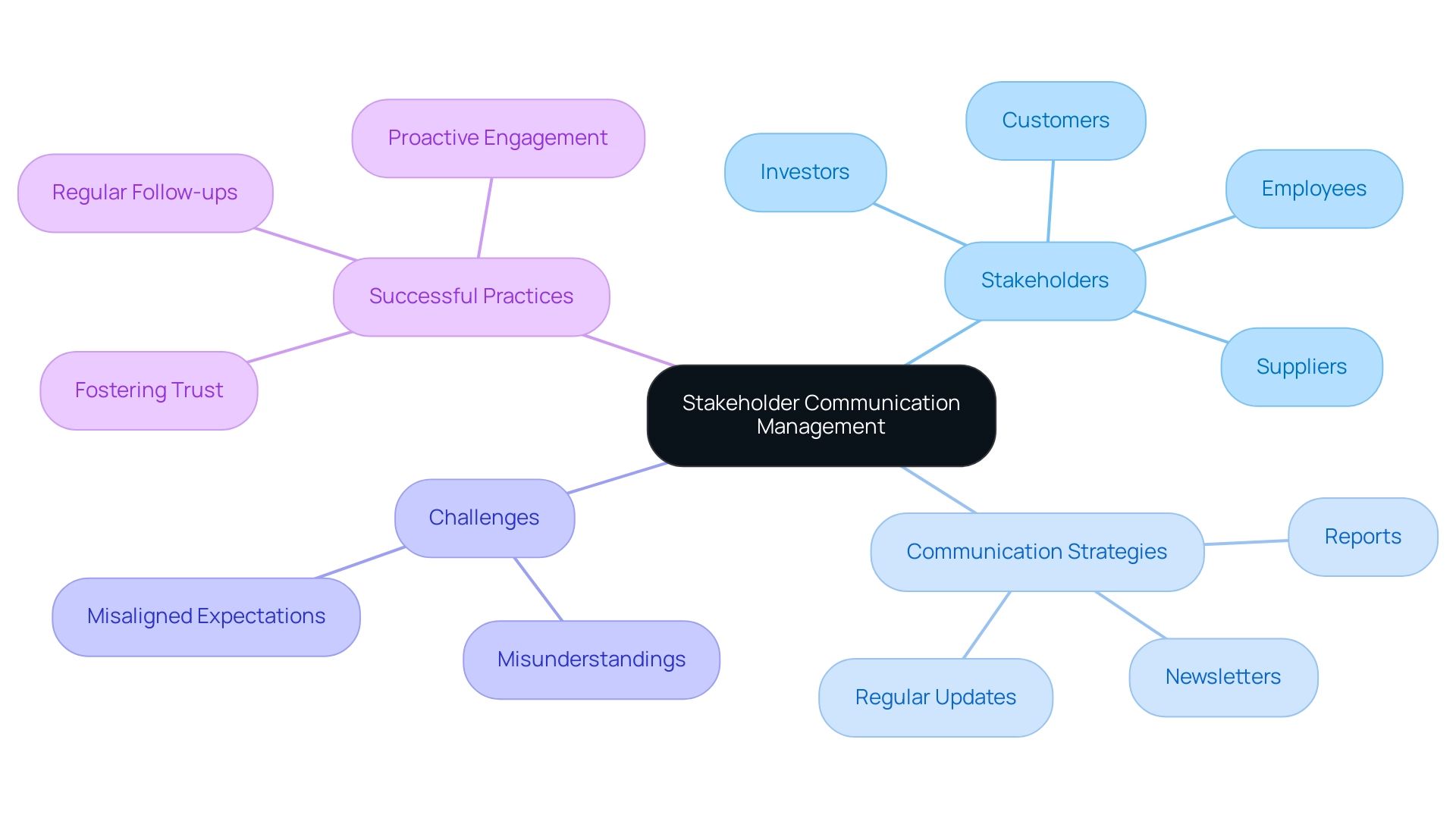
Proven Strategies for Effective Stakeholder Engagement
To enhance participant involvement and improve initiative outcomes, organizations should implement the following proven strategies:
- Regular Updates: Consistent communication is key. To ensure effective stakeholder and communications management, schedule regular updates through newsletters, meetings, or digital platforms to keep interested parties informed about project progress, challenges, and milestones. Notably, Salesforce's digital engagement dashboard tracks over 20 unique interaction points and reveals that individuals who invest more than 30 minutes monthly on their platform demonstrate a remarkable 65% increase in engagement rates. This emphasizes the significance of regular updates in stakeholder and communications management for promoting satisfaction among interested parties.
- Active Listening: Establishing forums for participants to express their concerns and suggestions is crucial. This can be accomplished through surveys, focus groups, or one-on-one meetings. The significance of active listening in stakeholder and communications management cannot be overstated; it fosters trust and ensures that participants feel heard.
- Tailored Communication: Acknowledge that interested parties have varying needs. Customize your communication style and content to cater to the preferences of different groups. This personalized approach enhances stakeholder and communications management by making the information shared more relevant and increasing participant investment in the project.
- Involve Participants in Decision-Making: Actively engaging participants in the planning and decision-making process cultivates a sense of ownership and commitment. For instance, Microsoft's Feedback Implementation Program successfully created dedicated 'action teams' that addressed input suggestions within 14 business days, achieving an impressive 87% success rate in implementing feedback.
- Feedback Mechanisms: Establish clear channels for receiving input from interested parties, ensuring that their contributions are valued and acted upon. Establishing a culture that prioritizes feedback not only strengthens relationships but also enhances overall satisfaction.
- Employ Centralized Platforms: Platforms such as TrueProject can greatly improve participant involvement by offering a centralized hub for interaction, collaboration, and transparency throughout the lifecycle of the initiative. By allowing involved parties to access real-time updates and relevant documents, organizations can further improve engagement and satisfaction.
By integrating these strategies, organizations can improve stakeholder and communications management, fostering stronger relationships with involved parties and ultimately creating a collaborative environment that supports project success.
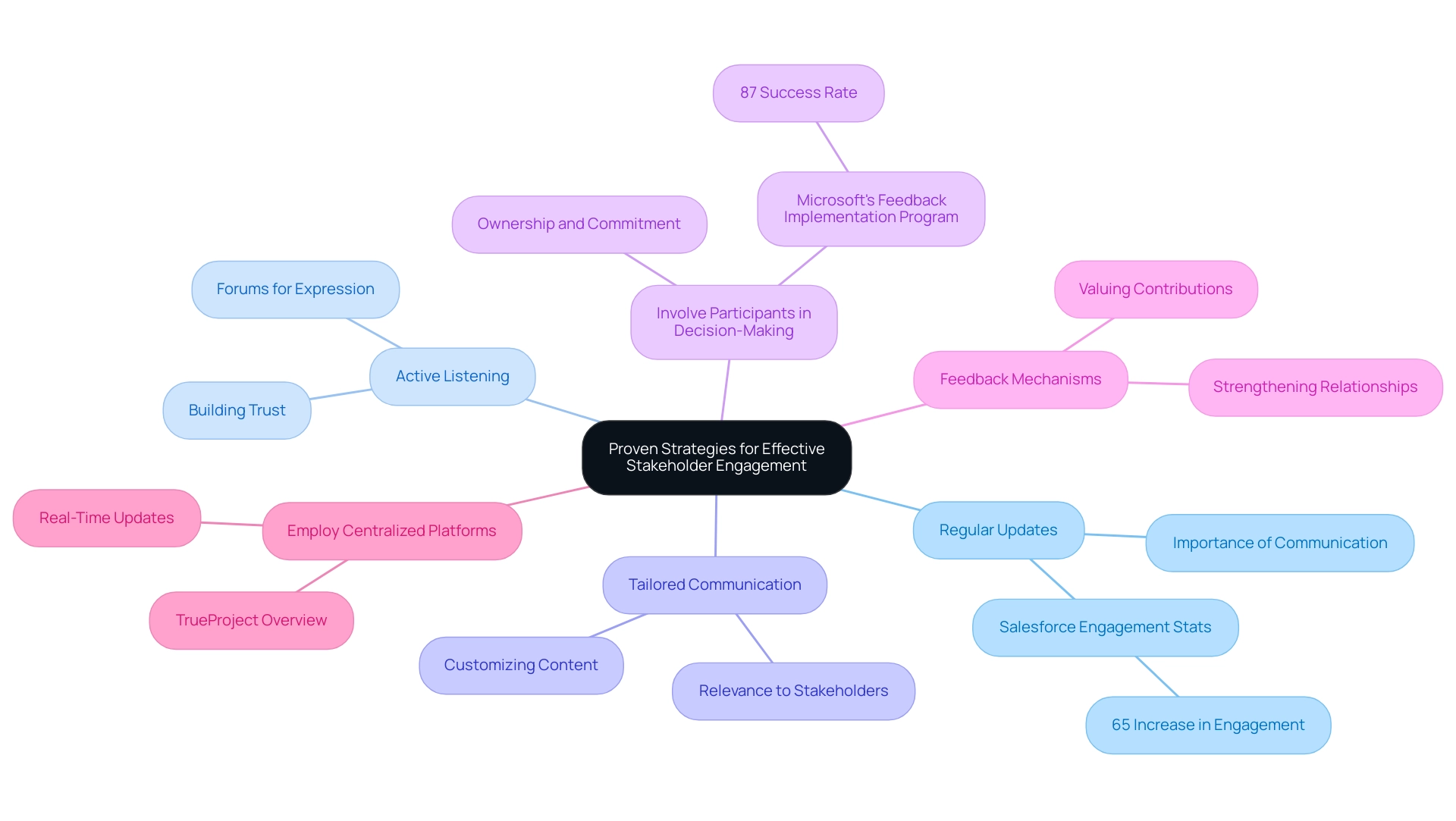
Utilizing Technology for Enhanced Communication
Organizations today can significantly enhance interactions and engagement through the strategic use of various technologies, which improve collaboration and responsiveness. Project management software such as Trello and Asana facilitates not only collaborative task management and real-time status updates but also supports a streamlined decision-making cycle that allows teams to take decisive action, essential during turnaround processes. This shortened decision-making cycle is crucial for preserving business momentum.
Video conferencing tools, including Zoom and Microsoft Teams, provide opportunities for face-to-face interactions, fostering personal connections that can mitigate the challenges of physical distance. Furthermore, customer relationship management (CRM) systems are crucial for tracking interactions, preferences, and feedback, allowing for tailored communication strategies that resonate with individual needs. As emphasized by a recent Deloitte analysis, companies that lose trust from their investors can experience value declines between 20% and 56%.
Thus, integrating these technologies not only enhances transparency and responsiveness but also strengthens relationships with interested parties, which is essential for stakeholder and communications management to achieve sustainable business success. Real-time business analytics through client dashboards enable continuous performance monitoring, empowering entities to adjust and optimize strategies based on immediate feedback, thus operationalizing lessons learned from previous turnaround efforts. The client dashboard serves as a vital tool in this process.
In this context, as Roger Roberts pointed out, the ongoing demand for talent in sectors like AI and renewable energy must be met with a commitment to technological resilience, particularly in navigating the complexities of managing various interests amidst current economic challenges, such as logistics and inflation. Furthermore, as entities increasingly depend on digital tools, case studies in cybersecurity and data privacy demonstrate that implementing measures such as data encryption and strict access controls is essential for maintaining trust and regulatory compliance. For instance, companies that have adopted robust data protection strategies have not only safeguarded sensitive information but also strengthened trust among interested parties, demonstrating the critical link between technology use and engagement.

Measuring the Effectiveness of Stakeholder Communication
To effectively evaluate participant interactions, organizations must implement robust metrics to assess their strategies. Key performance indicators (KPIs) should include:
- Participant satisfaction surveys
- Response times to inquiries
- Engagement levels during communication initiatives
Tools like those provided by Simply Stakeholders, including custom dashboards, analysis capabilities, and mapping tools, can greatly assist CFOs in this process.
For instance, Salesforce's digital engagement dashboard indicates that individuals who spend more than 30 minutes monthly on the platform demonstrate 65% higher engagement rates. By analyzing feedback from interested parties, organizations can uncover valuable insights for improvement. If interested parties express discontent about the frequency of updates, modifying information plans can assist in resolving these issues.
Additionally, identifying influential members within a target group and consulting them can amplify messaging and enhance participant engagement. Consistently assessing these metrics not only aligns organizations with the expectations of interested parties but also demonstrates a commitment to ongoing improvement in communication practices. The case study titled 'Monitor Engagement Levels' illustrates that categorizing participants based on their current or desired engagement status aids in setting objectives, tracking improvements, and planning tailored engagement strategies.
As Dr. Ari McGrew wisely notes,
Observe the unmet needs of the parties who require more attention.
This viewpoint encourages organizations to consider whether disengaged participants may represent opportunities for deeper understanding and involvement, ultimately leading to more effective interaction strategies.
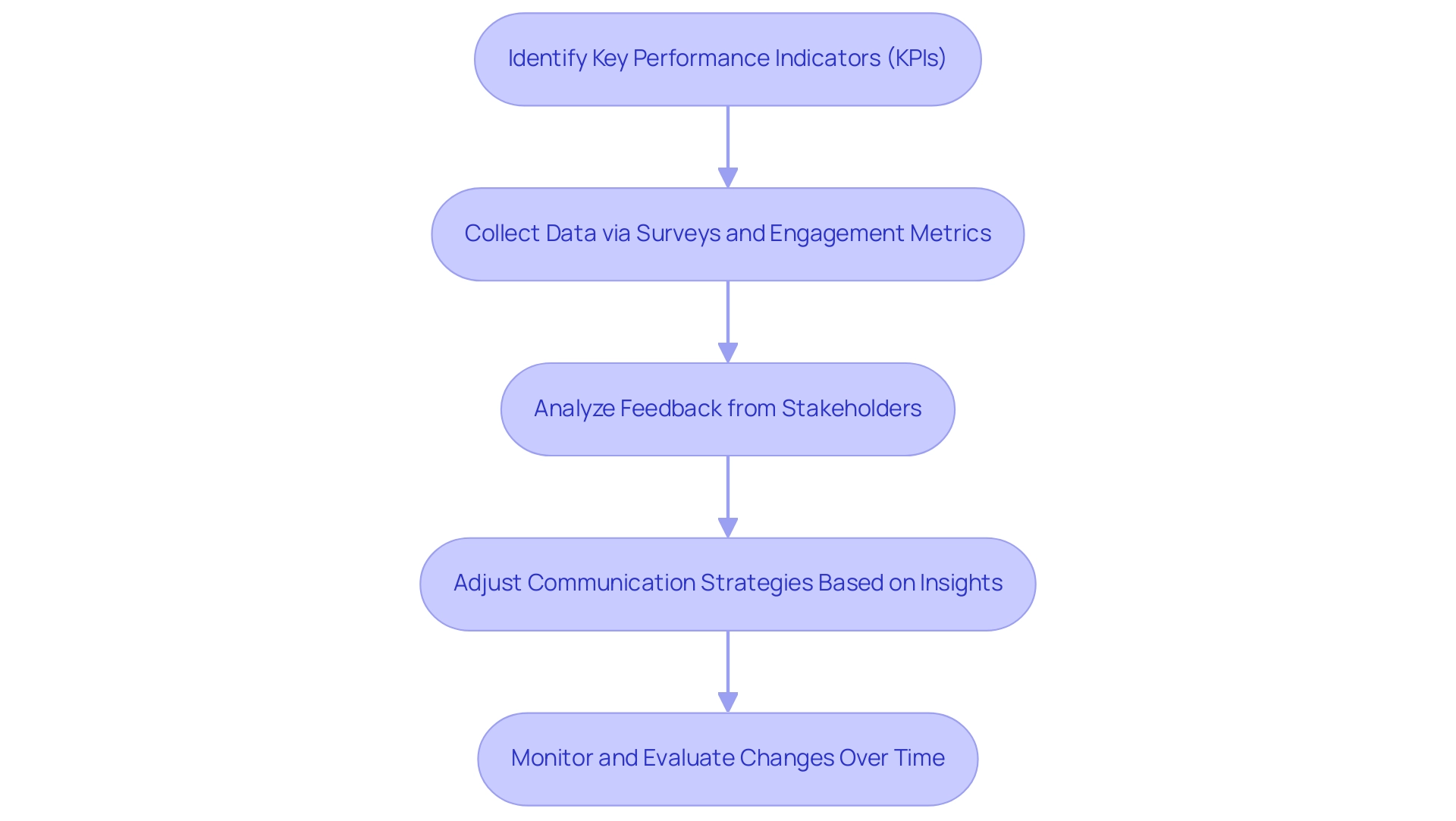
Crisis Communication: Strategies for Managing Uncertainty
During periods of crisis, the necessity for efficient exchange of information becomes crucial to stakeholder and communications management, which helps preserve trust among interested parties and alleviates panic. Organizations must create a strong crisis messaging strategy that clearly outlines key messages, information channels, and designated spokespersons. Trust needs to be built prior to a crisis through regular dialogue, openness, and compassion, ensuring participants are more inclined to adhere to directives during emergencies.
With more than half of employees affected by the Israeli-Palestinian conflict, nearly ten times the expected impact, the need for transparent communication is underscored. Effective stakeholder and communications management necessitates keeping stakeholders informed as situations unfold, detailing the steps being taken to address the crisis. Regular updates, even without new information, serve to reassure interested parties and combat misinformation.
Furthermore, creating a structured platform for participants to pose questions and share concerns fosters a sense of community and support during challenging times. By emphasizing transparent and sincere dialogue, entities can improve stakeholder and communications management during crises, thereby maintaining essential connections with important stakeholders. Effective leaders in a crisis, often referred to as 'leader communicators,' focus on genuine dialogue to mitigate crises and foster action among employees.
As noted by Powers,
But when a crisis occurs, organizations are usually pleased that the team has discussed this.
A well-prepared crisis response team, comprising representatives from leadership, public relations, legal, human resources, and operations, ensures clarity in roles and responsibilities. This structured approach facilitates swift and effective communication, ultimately mitigating potential damage during a crisis.
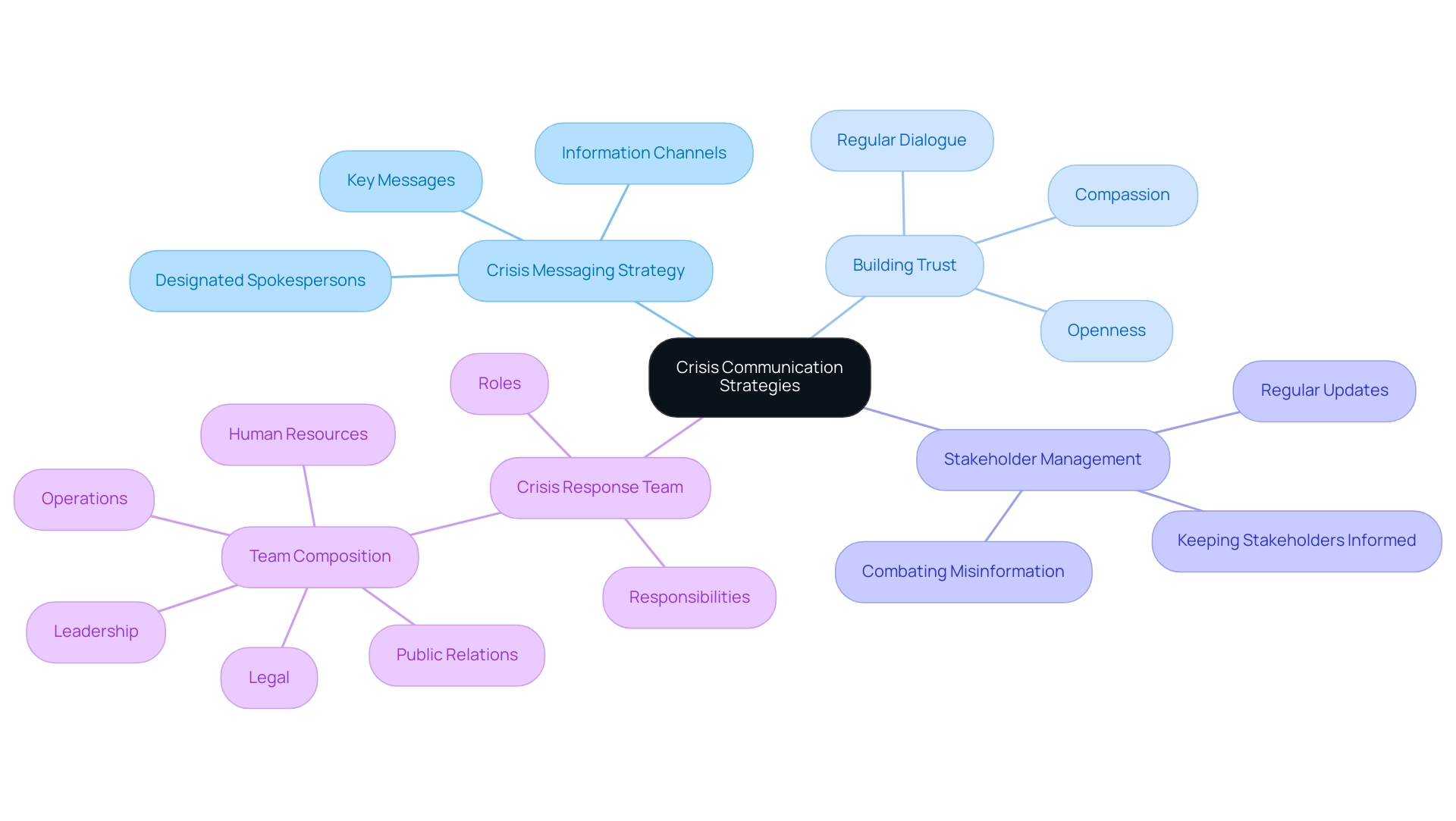
Building Long-Term Relationships with Stakeholders
To foster lasting connections with partners, organizations must emphasize involvement far beyond the limits of initiative phases. Research indicates that effective stakeholder and communications management leads companies to be 40% more likely to complete projects on time and within budget, underscoring the critical nature of these connections. However, it is also noteworthy that only 25 percent of employees report being inspired by their leaders, highlighting the importance of inspirational leadership in fostering engagement.
Our client engagement process starts with a thorough business review, aligning key participants and understanding the business context beyond mere numbers. Following this, our team identifies underlying business issues and collaboratively creates a strategic plan to mitigate weaknesses and reinforce strengths. This collaborative planning process ensures that all voices are heard and that the strategies developed are robust and effective.
Implementing regularly scheduled check-ins, appreciation events, and newsletters can significantly enhance and maintain these relationships. Creating opportunities for interested parties to participate in future initiatives or provide input not only enhances their engagement but also strengthens their dedication to the entity's vision, which is essential for effective stakeholder and communications management. Furthermore, recognizing and celebrating contributions from involved parties reinforces their value, fostering loyalty and support.
By adopting a relationship-centric approach, entities can secure the collaboration necessary to thrive in both the immediate and long-term landscape. The EDGE approach serves as a framework here, helping leaders create meaningful interactions that lead to lasting impact. In a post-COVID-19 environment, effective stakeholder and communications management will be crucial for redefining long-term value narratives by addressing the diverse needs of stakeholders—including institutional investors, customers, and communities.
For example, the case study 'Addressing Primacy of Interests' demonstrates how entities that effectively express their purpose and align their strategies with the expectations of stakeholders and communications management can enhance both their financial performance and shareholder satisfaction. As Justin Legacy, Account Manager and Business Development Team Leader, emphasizes, 'Building strong relationships through stakeholder and communications management is essential for long-term success.' Those organizations that embrace this philosophy are poised to thrive.
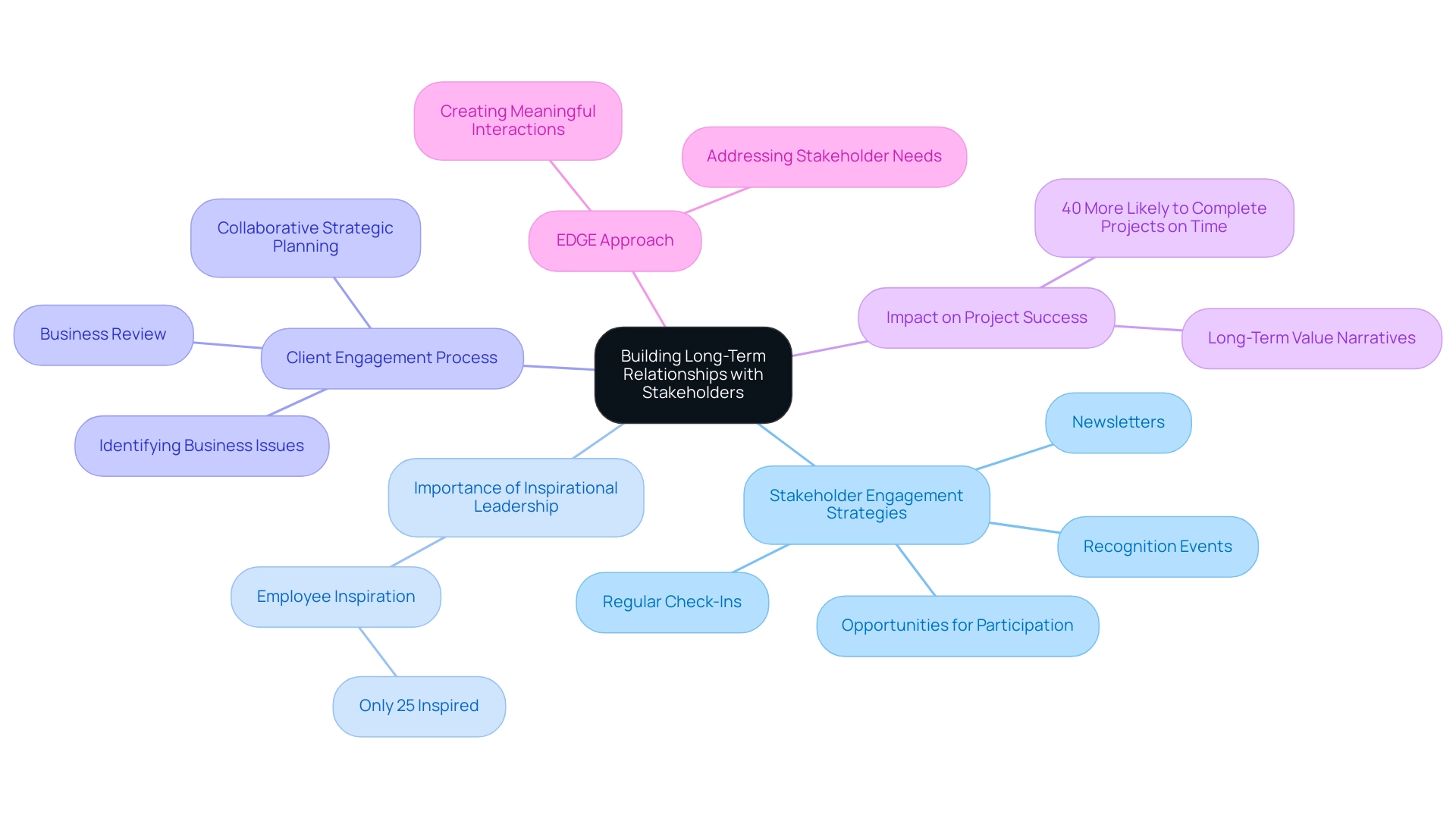
Conclusion
Effective stakeholder communication is a fundamental aspect of successful project management that cannot be overlooked. By establishing clear channels for information sharing and engagement, organizations can prevent misunderstandings and cultivate trust among all parties involved. The article has outlined several proven strategies for enhancing stakeholder engagement, including:
- Regular updates
- Active listening
- Tailored communication
- The incorporation of stakeholders in decision-making processes
Implementing these strategies not only strengthens relationships but also significantly improves project outcomes.
The role of technology in facilitating stakeholder communication has also been highlighted as a game-changer. By leveraging project management software, CRM systems, and digital engagement platforms, organizations can enhance transparency, responsiveness, and collaboration. This technological integration is crucial for maintaining stakeholder trust and ensuring that communication remains effective, especially in times of uncertainty.
Lastly, the importance of measuring communication effectiveness through robust metrics cannot be understated. By regularly assessing stakeholder satisfaction and engagement levels, organizations can refine their communication strategies and ensure alignment with stakeholder expectations. The insights gained from this ongoing evaluation process can lead to continuous improvement and stronger relationships that foster long-term success.
In summary, prioritizing stakeholder communication is essential for navigating the complexities of project management in today’s dynamic business environment. By adopting the strategies discussed, organizations can not only achieve project goals more efficiently but also build enduring partnerships that are vital for sustained growth and success. Embracing these practices will position organizations favorably in an increasingly competitive landscape, ensuring they thrive both now and in the future.
Frequently Asked Questions
What is the importance of stakeholder and communications management in initiatives?
Effective stakeholder and communications management is crucial as it serves as the foundation for successfully managing initiatives. It involves systematically sharing information, updates, and feedback among all parties, which helps prevent misunderstandings and misaligned expectations that could jeopardize success.
How does participant interaction impact the success of initiatives?
Strong participant interaction strategies are directly linked to the timely and budget-compliant attainment of objectives. Studies indicate that effective interaction practices can lead to significant variability in outcomes, with higher effectiveness scores correlating with better results.
What are the consequences of poor planning in stakeholder management?
Ineffective planning, particularly regarding managing expectations and communication with interested parties, can lead to major problems in initiatives, sometimes resulting in project closure.
What strategies can organizations implement to enhance participant involvement?
Organizations can enhance participant involvement by: 1. Providing regular updates through newsletters or meetings. 2. Practicing active listening via surveys or focus groups. 3. Tailoring communication to meet the varying needs of stakeholders. 4. Involving participants in decision-making processes. 5. Establishing feedback mechanisms to value and act on input. 6. Utilizing centralized platforms for improved collaboration and transparency.
How can regular updates benefit stakeholder management?
Regular updates keep interested parties informed about project progress, challenges, and milestones, which promotes satisfaction and engagement. Statistics show that individuals engaging regularly on digital platforms experience a significant increase in engagement rates.
What role does active listening play in stakeholder management?
Active listening fosters trust and ensures that participants feel heard, which is essential for effective stakeholder engagement. Establishing forums for feedback helps to address concerns and suggestions.
Why is tailored communication important in stakeholder management?
Tailored communication acknowledges that different stakeholders have varying needs. Customizing communication styles and content makes the information more relevant, enhancing engagement and investment in the project.
How can involving participants in decision-making affect project outcomes?
Actively engaging participants in the planning and decision-making process cultivates a sense of ownership and commitment, which can lead to higher success rates in implementing feedback and achieving project goals.
What are feedback mechanisms, and why are they important?
Feedback mechanisms are channels established to receive input from stakeholders, ensuring their contributions are valued and acted upon. Prioritizing feedback strengthens relationships and enhances overall satisfaction.
How can centralized platforms improve stakeholder engagement?
Centralized platforms, like TrueProject, provide a hub for interaction, collaboration, and transparency, allowing stakeholders to access real-time updates and relevant documents, thereby improving engagement and satisfaction throughout the project lifecycle.

